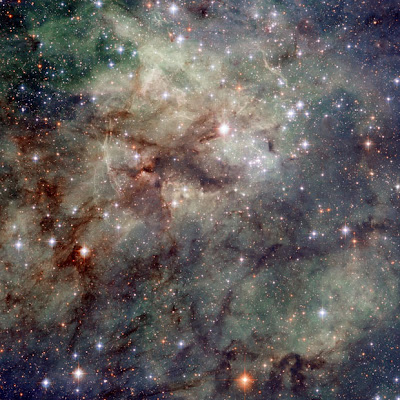Esta é mesmo do Telescópio Espacial Hubble, uma notável imagem de parte da famosa Nebulosa da Tarântula, uma vasta nuvem gás e poeira formadora de estrelas em nossa galáxia vizinha, a Grande Nuvem de Magalhães. Nessa foto, pode-se ver um close da região central da Tarântula, brilhando fortemente com gases ionizados e estrelas jovens.
Os finos braços da Nebulosa da Tarântula levaram originalmente ao pensamento que lembrava as pernas espigadas de uma aranha, dando à nebulosa esse nome incomum. A parte da nebulosa visível aqui nessa foto feita com a Câmera Avançada para Pesquisas, do Hubble, é entrecruzada com gavinhas de poeira e gás agitadas por supernovas recentes.
Esses remanescentes de supernovas incluem a NGC 2060, visível acima e à esquerda do centro da imagem, que contém o pulsar mais brilhante já conhecido. O Hubble e outros telescópios têm retornado regularmente para observar essa explosão estelar desde que ocorreu, em 1987, e cada visita subsequente mostra uma onda de choque em expansão iluminando o gás em torno da estrela, criando um colar de pérolas de bolsas de gás brilhantes ao redor dos remanescentes da estrela.
The Hubble Space Telescope has produced an outstanding image of part of the famous Tarantula Nebula, a vast star-forming cloud of gas and dust in our neighbouring galaxy, the Large Magellanic Cloud. In this picture, we see a close-up of the Tarantula's central region, glowing brightly with ionised gases and young stars.
The wispy arms of the Tarantula Nebula were originally thought to resemble spindly spider legs, giving the nebula its unusual name. The part of the nebula visible in this image from Hubble's Advanced Camera for Surveys is criss-crossed with tendrils of dust and gas churned up by recent supernovae.
These supernova remnants include NGC 2060, visible above and to the left of the centre of this image, which contains the brightest known pulsar. Hubble and other telescopes have been returning to spy on this stellar explosion regularly since it blew up in 1987, and each subsequent visit shows an expanding shockwave lighting up the gas around the star, creating a pearl necklace of glowing pockets of gas around the remains of the star.

Nenhum comentário:
Postar um comentário